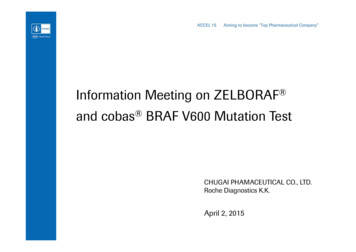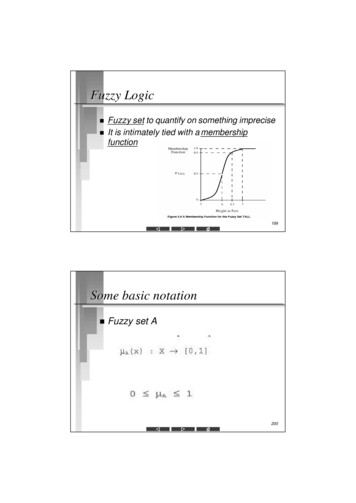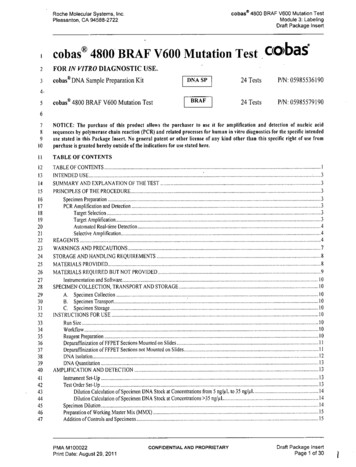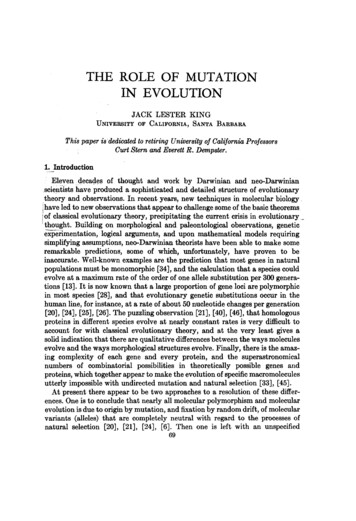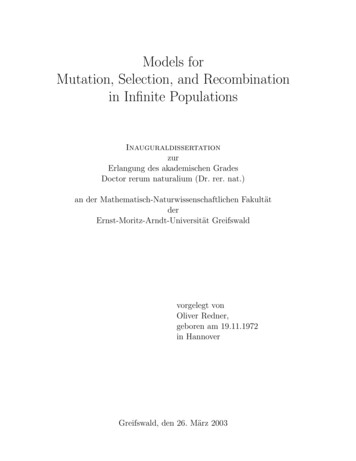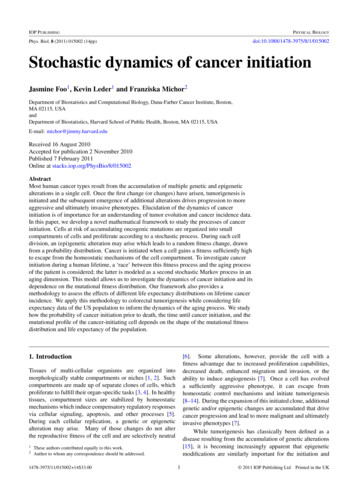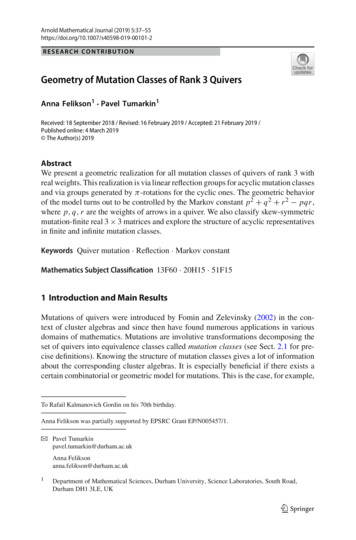
Transcription
Arnold Mathematical Journal (2019) 2RESEARCH CONTRIBUTIONGeometry of Mutation Classes of Rank 3 QuiversAnna Felikson1 · Pavel Tumarkin1Received: 18 September 2018 / Revised: 16 February 2019 / Accepted: 21 February 2019 /Published online: 4 March 2019 The Author(s) 2019AbstractWe present a geometric realization for all mutation classes of quivers of rank 3 withreal weights. This realization is via linear reflection groups for acyclic mutation classesand via groups generated by π -rotations for the cyclic ones. The geometric behaviorof the model turns out to be controlled by the Markov constant p 2 q 2 r 2 pqr ,where p, q, r are the weights of arrows in a quiver. We also classify skew-symmetricmutation-finite real 3 3 matrices and explore the structure of acyclic representativesin finite and infinite mutation classes.Keywords Quiver mutation · Reflection · Markov constantMathematics Subject Classification 13F60 · 20H15 · 51F151 Introduction and Main ResultsMutations of quivers were introduced by Fomin and Zelevinsky (2002) in the context of cluster algebras and since then have found numerous applications in variousdomains of mathematics. Mutations are involutive transformations decomposing theset of quivers into equivalence classes called mutation classes (see Sect. 2.1 for precise definitions). Knowing the structure of mutation classes gives a lot of informationabout the corresponding cluster algebras. It is especially beneficial if there exists acertain combinatorial or geometric model for mutations. This is the case, for example,To Rafail Kalmanovich Gordin on his 70th birthday.Anna Felikson was partially supported by EPSRC Grant EP/N005457/1.BPavel Tumarkinpavel.tumarkin@durham.ac.ukAnna Feliksonanna.felikson@durham.ac.uk1Department of Mathematical Sciences, Durham University, Science Laboratories, South Road,Durham DH1 3LE, UK123
38A. Felikson, P. Tumarkinfor adjacency quivers of triangulations of bordered marked surfaces (Fock and Goncharov 2006; Gekhtman et al. 2005; Fomin et al. 2008), where mutations correspondto flips of triangulations.There is a model for mutations of quivers containing a representative without oriented cycles in their mutation class (such quivers are called mutation-acyclic): it wasshown in (Speyer and Thomas 2013; Seven 2015) that mutations of mutation-acyclicquivers can be modeled by reflections of a tuple of positive vectors in a certain quadraticspace (we call this a realization by reflections). One of the goals of this paper is to construct a model for mutations of mutation-cyclic quivers of rank 3, and thus to obtain ageometric realization for every quiver of rank 3 (Theorem 3.6). In particular, we provethat mutations of mutation-cyclic rank 3 quivers can be modeled by π -rotations intriples of points on a hyperbolic plane.Mutation classes of rank 3 quivers were studied in Assem et al. (2008), Beineke et al.(2011), Berenstein et al. (2006), Felikson et al. (2012), Seven (2012) and Warkentin(2014). In particular, the Markov constant C(Q) p 2 q 2 r 2 pqr for a cyclicquiver Q with weights ( p, q, r ) was introduced in Beineke et al. (2011) and proved tobe mutation-invariant. Combining our results with ones of Beineke et al. (2011), weshow that C(Q) defines the type and geometric properties of realizations of all rank 3quivers (Theorem 4.4). For mutation-acyclic quivers, C(Q) also controls the signatureof the quadratic space where mutations are modeled by reflections. More precisely,after considering appropriate projectivization, C(Q) chooses between the sphere S2 ,Euclidean plane E2 and the hyperbolic plane H2 , see Remark 4.7.Throughout the whole paper, we allow a quiver to have real weights, so all the resultsconcern a more general class of quivers than is usually considered (see also Lampe2018). A quiver is mutation-finite if its mutation class is finite. The classification ofmutation-finite quivers with integer weights in rank 3 is extremely simple: there aretwo quivers in the mutation class of an orientation of A3 Dynkin diagram, two quivers(1)in the mutation class of an acyclic orientation of A2 extended Dynkin diagram,and the Markov quiver. However, in the case of real weights the question is moreinteresting, we classify all the finite mutation classes in rank 3 in Theorem 5.9, which,in its turn, leads to the complete classification of mutation-finite quivers with realweights (Felikson and Tumarkin 2019).Finally, we discuss the structure of acyclic representatives in mutation classes.According to Caldero and Keller (2006), all acyclic quivers in any integer mutationclass can be mutated to each other via sink-source mutations only, i.e. by mutations invertices incident to incoming (or outgoing) arrows only. This is not the case for quiverswith real weights: already finite mutation classes may have two essentially distinctacyclic representatives (see Table 1), and infinite mutation classes have infinitely manyones which are distributed densely, see Theorem 6.2.2 Mutation-Acyclic Quivers via ReflectionsIn this section we model mutations of a mutation-acyclic rank 3 quiver via somelinear reflection group acting on S2 , E2 or H2 . The results of this section can be123
Geometry of Mutation Classes of Rank 3 Quivers39deduced from Barot et al. (2006) [see also Seven (2015), Speyer and Thomas (2013)and Felikson and Tumarkin (2018) for more general picture], we give a geometricinterpretation and observe that taking real weights instead of integer ones does notaffect the proofs.2.1 Quiver MutationsA quiver Q is an oriented graph with weighted edges without loops, 2-cycles andmultiple edges. We allow the weights to be any positive real numbers. We call thedirected edges arrows. By rank of Q we mean the number of its vertices.For every vertex k of Q we define an involutive operation μk called mutation ofQ in direction k. It gives a new quiver μk (Q) which can be obtained from Q in thefollowing way (see Fomin and Zelevinsky 2002):– orientations of all arrows incident to the vertex k are reversed, weights remainintact;– for every pair of vertices (i, j) such that Q contains arrows directed from i to kand from k to j the weight of the arrow joining i and j changes as described inFig. 1.Given a quiver Q, its mutation class is a set of all quivers (considered up to isomorphism) obtained from Q by all sequences of iterated mutations. All quivers fromone mutation class are called mutation-equivalent.Quivers without loops and 2-cycles are in one-to-one correspondence with realskew-symmetric matrices B {bi j }, where bi j 0 if and only if there is an arrowfrom ith vertex to jth one with weight bi j . In terms of the matrix B the mutation μkcan be written as μk (B) B , wherebi j bi j , b b b b bi j ik k j 2 ik k j ,if i k or j k;otherwise.A rank 3 quiver (and the corresponding 3 3 matrix) is called cyclic if its arrowscompose an oriented cycle, and is called acyclic otherwise. A quiver (and the matrix)is mutation-cyclic if all representatives of the mutation class are cyclic, and mutationacyclic otherwise.Fig. 1 Quiver mutations. Thesign before r (resp., r ) ispositive if the vertices of Q(resp., Q ) form an orientedcycle, and negative otherwise.Either r or r may vanishkpkqrµk r r pqpqr 123
40A. Felikson, P. Tumarkin2.2 Construction2.2.1 Initial ConfigurationLet Q be an acyclic rank 3 quiver and let B be the corresponding skew-symmetric3 3 matrix. Consider a symmetric matrix with non-positive off-diagonal entriesM(B) (m i j ), where m ii 2, m i j bi j if i j.M(B) defines a quadratic form, and we can consider it as the matrix of inner productsof some triple of vectors (v1 , v2 , v3 ) in a quadratic space V of the same signature asM(B) has. Considering the projectivization P(V ) V /R , the images li of thehyperplanes Πi vi define lines in a space X of constant curvature, where X is thesphere S2 if M(B) is positive definite, a Euclidean plane E2 if M(B) is degeneratepositive semidefinite, or H2 if M(B) is of signature (2, 1). The scalar product (vi , v j )characterizes the mutual position of the corresponding lines: 2 cos (Πi , Π j ) 2 (vi , v j ) 2 2 cosh d(li , l j ) 2if li intersects l j ,if li is parallel to l j ,otherwise,where d(li , l j ) is the distance between diverging lines in H2 .Consider also the halfplanes li {u P(V ) (u, vi ) 0}, let F l1 l2 l3 .Since (vi , v j ) 0, F is an acute-angled domain (i.e., F has no obtuse angles).2.2.2 Reflection GroupGiven a vector vi V with (vi , vi ) 2 one can consider a reflection with respect toli vi defined by ri (u) u (u, vi )vi . Reflections preserve the scalar product inV , and ri (vi ) vi , i.e. ri is an isometry of X preserving li and interchanging thehalfspaces into which X is decomposed by li . We denote by G the group generatedby reflections r1 , r2 , r3 .2.2.3 MutationThe initial acyclic quiver Q (and matrix B) corresponds to the initial set of generatingreflections in the group G and to the initial domain F P(V ). Applying mutations,we will obtain other sets of generating reflections in G as well as other domains inP(V ).More precisely, define mutation of the set of generating reflections by partial conjugation: μk (r j ) rk r j rk if b jk 0, and μk (r j ) r j otherwise. Consequently,the mutation of the triple of vectors (and of the triple of lines) is defined by partialreflection: v j (v j , vk )vk if b jk 0,μk (v j ) vkif j k, otherwise.vj123
Geometry of Mutation Classes of Rank 3 Quivers41Note that the mutation as defined above is not an involution. To fix this, choose a vectoru F and define μk as above (i.e. reflecting v j if b jk 0) for the case (u, vk ) 0,and by reflection of v j if b jk 0 for the case (u, vk ) 0. Applications of two versionsof the definition differ by reflection in vk only. Throughout the paper we will mostlyuse the configurations up to conjugation by an element of G, so it will be sufficientfor us to use the initial definition.2.3 Geometric Realization by ReflectionsLemma 2.1 (Barot et al. (2006), Corollary of Proposition 3.2) Let Q be a rank 3quiver, and let B be the corresponding skew-symmetric matrix. Let V v1 , v2 , v3be a quadratic space and suppose that(1) (vi , vi ) 2 for i 1, 2, 3, (vi , v j ) bi j for 1 i j 3;(2) if (vi , v j ) 0 for all i j, then the number of pairs (i, j) such that i j and(vi , v j ) 0 is even if Q is acyclic and odd if Q is cyclic.Then the set of vectors v (μk (v1 ), μk (v2 ), μk (v3 )) satisfies conditions (1)–(2) forB μk (B).We note that the statement of (Barot et al. 2006, Proposition 3.2) is formulatedin terms of quasi-Cartan companions, which are Gram matrices of tuples of vectors{v1 , v2 , v3 }, and their mutations, which are precisely changes of bases correspondingto our mutations v v defined above.The statement of the lemma is proved in Barot et al. (2006) for integer skewsymmetrizable matrices, however, their proof works for real skew-symmetric matricesas well. One can also note that for any skew-symmetric matrix B there exists a quadraticthree-dimensional space V and a triple of vectors v1 , v2 , v3 V satisfying the assumptions of the lemma.Definition 2.2 Let B be a 3 3 skew-symmetric matrix. We say that a tuple of vectorsv (v1 , v2 , v3 ) is a geometric realization by reflections of B if conditions (1)–(2)of Lemma 2.1 are satisfied. We also say that v provides a realization of the mutationclass of B if the mutations of v via partial reflections agree with the mutations of B,i.e. if conditions (1)–(2) are satisfied after every sequence of mutations.Given a geometric realization (v1 , v2 , v3 ) of B, consider the lines li {u (u, vi ) 0}. The (unordered) triple of lines (l1 , l2 , l3 ) will be also called a geometric realizationby reflections of B (note that properties (1)–(2) do not depend on the choice of vectorsorthogonal to (l1 , l2 , l3 )). A realization of B will also be called a realization of thecorresponding quiver Q.Corollary 2.3 Every acyclic mutation class has a geometric realization by reflections.Proof In view of Lemma 2.1 it is sufficient to find a geometric realization for an acyclicquiver. This is provided by the construction above (notice that for the initial acyclic quiver we get (vi , v j ) 0, so condition (2) holds).123
42A. Felikson, P. TumarkinRemark 2.4 In contrast to quivers with integer weights, mutation classes of quivers withreal weights may have more than one acyclic representative (modulo sink-source mutations), we discuss this in the last section. Meanwhile, we observe that by Lemma 2.1 atriple of lines corresponding to any acyclic quiver determines an acute-angled domain,while a triple corresponding to a cyclic quiver determines a domain with an obtuseangle.3 Mutation-Cyclic Quivers via -Rotations3.1 ConstructionSimilarly to acyclic mutation classes realized by partial reflections in S2 , E2 or H2 , wewill use π -rotations in H2 to build a geometric realization for mutation-cyclic classes.3.1.1 Initial ConfigurationLet Q be a cyclic rank 3 quiver and let B be the corresponding skew-symmetric 3 3matrix (we will assume b12 , b23 , b31 0). We will also assume bi j 2 for all i j(in view of Lemma 3.3 below this is the case for quivers in mutation-cyclic classes).Let V be a quadratic space of signature (2, 1), suppose that v1 , v2 , v3 are negativevectors with (vi , vi ) 2, (vi , v j ) bi j for i j. Then vi correspond to pointsin the hyperbolic plane H2 , the product (vi , v j ) represents the distance d(vi , v j ), i.e.,(vi , v j ) 2 cosh d(vi , v j ).It is not immediately evident that for every mutation-cyclic matrix B there is acorresponding triple of vectors v1 , v2 , v3 , we will prove this in Sect. 4.3.1.2 -Rotations GroupWith every x H2 (i.e., with every negative v V ) we can associate a rotation byπ around x. A π -rotation Rv about v, (v, v) 2, acts as Rv (u) u (u, v)v.Given three points v1 , v2 , v3 , we can generate a group G Rv1 , Rv2 , Rv3 actingon H2 .3.1.3 MutationThe initial matrix B corresponds to the initial set of generating rotations in the groupG and to the initial triple of points in H2 . Applying mutations, we will obtain othersets of generating rotations of G as well as other triples of points.More precisely, define mutation of the set of generating rotations by partial conjugation, in exactly the same way as for reflections: μk (r j ) rk r j rk if b jk 0, andμk (r j ) r j otherwise. Consequently, the mutation of the triple of points is definedby partial rotation: v j (v j , vk )vk if b jk 0,μk (v j ) otherwise.vi123
Geometry of Mutation Classes of Rank 3 Quivers433.2 Geometric Realization by -RotationsLemma 3.1 Let Q be a cyclic quiver of rank 3 with all weights greater or equal to 2,let B be the corresponding skew-symmetric matrix with b12 , b23 , b31 0, and let V bethe corresponding quadratic space. Suppose that v1 , v2 , v3 V are vectors satisfying(vi , vi ) 2, (vi , v j ) bi j for 1 i j 3.Then Q μk (Q) is a cyclic quiver with weights greater or equal to 2, and the setof vectors v (μk (v1 ), μk (v2 ), μk (v3 )) satisfies the assumptions of the lemma forB μk (B).Proof Due to the symmetry, to prove the lemma we only need to check one mutation ,(say, μ2 ). A direct computation shows that (v1 , v3 ) (b12 b23 b31 ) b13 (v1 , v2 ) (v1 , v2 ) b12 , (v2 , v3 ) (v2 , v3 ) b23 . As v1 and v3 are negative, b 2, i.e.(v1 , v3 ) 2 cosh d(v1 , v3 ) 2 0, which implies that b3113 Q μ2 (Q) is a cyclic quiver with b12 , b23 , b31 2 for B μ2 (B). Also, the computation above shows that the assumptions are satisfied by v and B .Notation 3.2 From now on, given a cyclic quiver we denote its weights by p b12 ,q b23 , r b31 . We will also denote the corresponding matrix B by a triple( p, q, r ).A quiver is called minimal if the sum of its weights is minimal across the wholemutation class.Lemma 3.3 Let Q be a cyclic quiver with weights p, q, r 0.(a) if r 2 then Q is mutation-acyclic;(b) if r 2 and p q then Q is mutation-acyclic;(c) if r 2 and p q 2 then Q is mutation-cyclic, and Q is minimal in itsmutation class.Proof (a) We will apply mutations μ1 and μ3 alternately (starting from μ3 ), so that atevery step b13 r stays intact. Furthermore, each of the steps changes either b12 or b23 as follows:Claim 1 For n N denote Q n (μ1 μ3 )n/2 Q if n is even or Q n μ3 (μ1 μ3 )(n 1)/2 Qif n is odd. If all Q k are cyclic for k n, then the entries of the corresponding matrixBn satisfy b12 (or b23 ) f n ( p, q, r ) u n (r )q u n 1 (r ) p,where u n (x) is a Chebyshev polynomial of the second kind (of a half-argument) recursively defined by u 0 (x) 1, u 1 (x) x, u n 1 (x) xu n (x) u n 1 (x).The proof is an easy induction: μ3 ( p, q, r ) (rq p, q, r ), and the step is given byμ μ1 or μ3 with μ( f n , f n 1 , r ) ( f n 2 , f n 1 , r ). The claim can also be extractedfrom (Lee and Schiffler (2015), Lemma 3.2).Claim 2 For any real p, q, r 0 s.t. r 2 there exists n Z such that u n 1 (r )q u n (r ) p 0.123
44A. Felikson, P. TumarkinTo prove the claim, we will use Chebyshev polynomials of the second kind definedbyU0 (y) 1, U1 (y) 2y, Un 1 (y) 2yUn (y) Un 1 (y).Notice that if x 2y then u n (x) Un (y). For 0 r 2 we can write r 2 cos θfor some 0 θ π/2. Then we haveu n (r ) Un (cos θ ) sin((n 1)θ ),sin θwhere the last equality is a well-known property of Chebyshev polynomials of thesecond kind. If u n 1 (r )q u n (r ) p 0, thensin((n 1)θ )sin(nθ )q p,sin θsin θor just sin((n 1)θ )q sin(nθ ) p, as sin θ 0. Since 0 θ π/2, there existsn 0 such that sin(kθ ) 0 for all 0 k n but sin((n 1)θ ) 0. This gives thenumber n required in Claim 2.Combining the two claims we see that there exists n N such that Q n is acyclic,which completes the proof of part (a).(b) If r 2 then u n (r ) n 1, so, the condition u n 1 (r )q u n (r ) p 0 turns into(n 1)q np 0. Assuming q p, this cannot hold if n is large enough.(c) If p q 2 and r 2 then there exist points v1 , v2 , v3 in H2 realizing B (q, q, r ). Indeed, we take v1 v3 , and choose any v2 such that 2 cosh d(v1 , v2 ) q(as usual, we assume (vi , vi ) 2). Applying repeatedly Lemma 3.1 we see that inthis case Q is mutation-cyclic. Moreover, the mutated triple of points always remainscollinear, and it is easy to see that every new mutation either increases the distances inthe triple or brings it to the previous configuration. This implies that the initial quiverQ was minimal. Similarly to realizations by reflections (see Definition 2.2) we define realizationsby π -rotations.Definition 3.4 Let B be a 3 3 skew-symmetric matrix. We say that a triple of vectorsv (v1 , v2 , v3 ) is a geometric realization by π -rotations of B if the assumptions ofLemma 3.1 hold. We also say that v provides a realization of the mutation class of Bif the mutations of v via partial π -rotations agree with all the mutations of B, i.e. ifthe assumptions of Lemma 3.1 hold after every sequence of mutations.We can now formulate the following immediate corollary of Lemma 3.1.Lemma 3.5 A mutation-acyclic quiver has no realization by π -rotations.Theorem 3.6 Let Q be a mutation-cyclic rank 3 quiver, and let B be the correspondingskew-symmetric matrix. Then the mutation class of B has a realization by reflectionsor a realization by π -rotations.123
Geometry of Mutation Classes of Rank 3 Quivers45Proof Since Q is mutation-cyclic, Lemma 3.3 implies that B ( p, q, r ) withp, q, r 2. If there is a triple of points on H2 on mutual distances d p , dq , dr 0,where dx arccosh x2 , then Lemma 3.1 guarantees the realization by π -rotations (as2 cosh d(u, v) (u, v)). Such a triple of points on H2 does exist if and only if thetriangle inequality holds for d p , dq , dr .If we assume that the triangle inequality does not hold, then it is an easy exercise in hyperbolic geometry to find a triple of lines l p , lq , lr in H2 such thatd p d(lq , lr ), dq d(l p , lr ) and dr d(lq , l p ), and two of these are separated by the third one (as in Fig. 2, left). This provides us with a realization byreflections. 4 Geometry Governed by the Markov ConstantDefinition 4.1 The Markov constant C( p, q, r ) for a triple ( p, q, r ), where p, q, r R, was introduced by Beineke et al. (2011) asC( p, q, r ) p 2 q 2 r 2 pqr .For a cyclic quiver Q with weights p, q, r , C(Q) is defined as C( p, q, r ), whilefor an acyclic quiver with weights p, q, r one has C(Q) : C( p, q, r ) (this can beunderstood as turning an acyclic quiver into a cycle at the price of having a negativeweight). It is observed in Beineke et al. (2011) that C(Q) is a mutation invariant,it was also shown in Beineke et al. (2011) that in the case of integer weights C(Q)characterizes (with some exceptions) the mutation-acyclic quivers:Proposition 4.2 (Beineke et al. (2011), extract from Theorem 1.2) Let Q be a rank3 cyclic quiver with integer weights given by p, q, r Z 0 . Then the followingconditions are equivalent.(1) Q is mutation-cyclic;(2) p, q, r 2 and C( p, q, r ) 4;(3) C( p, q, r ) 0 or Q is mutation-equivalent to one of the following classes:(a) C( p, q, r ) 0, ( p, q, r ) is mutation-equivalent to (3, 3, 3);(b) C( p, q, r ) 4, ( p, q, r ) is mutation-equivalent to (q, q, 2) for some q 2.Our next aim is to give a geometric interpretation of C(Q) as well as to extend theresult to the case of real numbers p, q, r .Fig. 2 No realization byreflections for mutation-cyclicquiverslqdplrlplqlpdrdq( a)lr( b)123
46A. Felikson, P. TumarkinThe question of recognizing whether a quiver Q is mutation-acyclic is non-trivialif Q is not acyclic itself [i.e. Q is a cycle ( p, q, r )] and if p, q, r 2 [otherwisewe just use Lemma 3.3(a)]. For quivers of this type, the proof of Theorem 3.6 showsthat Q can be realized by π -rotations (and is mutation-cyclic by Lemma 3.5) or byreflections depending on the triangle inequality for dr d p dq , where p q rand dx arccosh x2 . DenoteΔ(Q) d p dq dr ,understanding Δ(Q) 0 as “triangle inequality holds” and Δ(Q) 0 as “it doesnot”.Lemma 4.3 Let Q ( p, q, r ) be a rank 3 cyclic quiver with 2 p q r . Then– if Δ(Q) 0 then C(Q) 4;– if Δ(Q) 0 then C(Q) 4;– if Δ(Q) 0 then C(Q) 4.Proof Δ(Q) 0 if and only if cosh(d p dq ) cosh(dr ). Since cosh(dx ) x/2, wehave pqpq sinh arccoshsinh arccoshcosh(d p dq ) 2222 pq 4p2 14q2 1 .4Hence, Δ(Q) 0 is equivalent to ( p 2 4)(q 2 4) 2r pq. Therefore, Δ(Q) 0 implies ( p 2 4)(q 2 4) (2r pq)2 , i.e. 4 p 2 q 2 r 2 pqr C(Q).An easy calculation shows that C(Q) 4 and 2 p q r imply 2r pq 0,so C(Q) 4 also implies Δ(Q) 0. Theorem 4.4 Let Q be a rank 3 quiver with real weights. Then(1) if Q is mutation-acyclic then C(Q) 0 and Q admits a realization by reflections;(2) if Q is mutation-cyclic then C(Q) 4 and Q admits a realization by π -rotations;(3) Q admits both realizations (by reflections and by π -rotations) if and only if Q iscyclic with p, q, r 2 and C(Q) 4.Proof (1) If Q is mutation-acyclic, consider the acyclic representative (we may assumeit is Q itself). Then C(Q) 0 as it is a sum of four non-negative terms. Existence ofa realization by reflections is guaranteed by Corollary 2.3.(2) If Q ( p, q, r ) is mutation-cyclic, then by Lemma 3.3(a) we have p, q, r 2,and by Theorem 3.6 Q has a realization either by reflections in H2 or by π -rotations(again, in H2 ). Which of the options holds depends on the triangle inequality, i.e., onthe sign of Δ(Q), which is determined by the sign of 4 C(Q). More precisely, ifC(Q) 4 then the triangle inequality holds and Q has a realization by π -rotations,and if C(Q) 4 then Q has a realization by reflections.123
Geometry of Mutation Classes of Rank 3 Quivers47Suppose that a mutation-cyclic quiver Q has C(Q) 4 and, hence, has a realizationby reflections. It is shown in Section 5 of Beineke et al. (2011) that every mutationcyclic class with C(Q) 4 contains a minimal element Q min , where the sum of theweights p q r is minimal over the whole mutation class [notice that Beinekeet al. (2011) shows this for all mutation classes with real weights]. Consider therealization of Q min ( pmin , qmin , rmin ). As Q min is still mutation-cyclic, we havepmin , qmin , rmin 2 which implies that the lines l p , lq , lr in the realization of Q min donot intersect each other. If one of the lines (say, lr ) separates the others (see Fig. 2a),then partial reflection in lr (reflection of exactly one of l p and lq ) decreases one of thethree distances, which contradicts the assumption that Q min is minimal in the mutationclass. If none of these lines separates the other two (see Fig. 2b), then for any choice ofnormal vectors there will be even number of positive scalar products (vi , v j ), whichdoes not agree with Definition 2.2 for a cyclic quiver.By Theorem 3.6, the contradiction shows that every mutation-cyclic quiver Q hasC(Q) 4, admits a realization by π -rotations, and does not admit a realization byreflections if C(Q) 4.(3) First, by Lemma 3.5 a mutation-acyclic quiver cannot be realized by π -rotations.Next, a mutation-cyclic quiver with C(Q) 4 cannot be realized by reflectionsas shown in the proof of part (2). Finally, suppose that Q is mutation-cyclic andC(Q) 4. Then there is a realization of Q by π -rotations about 3 collinear points(as C(Q) 4 is equivalent to the equality in the triangle inequality). Now, considerthe line l containing these three points. Taking three lines through these three pointsorthogonal to l gives a realization by reflections. Remark 4.5 (On realizations of (2, 2, 2)) In case of the quiver (2, 2, 2) both realizationsabove are very degenerate (i.e., either reflections with respect to three coinciding linesor π -rotations with respect to three coinciding points). However, one can also considera realization by reflections with respect to three mutually parallel lines (in E2 or H2 ),this will lead to an infinite group G.Remark 4.6 As it is mentioned in Section 5 of Beineke et al. (2011), if Q is mutationcyclic with C(Q) 4 then the mutation class of Q may have no minimal quiver.Having in mind any of the two realizations of Q described above, it is clear that amutation-cyclic Q ( p, q, r ) has a minimal representative in the mutation class if/ Q then we can always make the distances betweenand only if d p /dq Q. If d p /dq three collinear points (or between three lines) as small as we want, which means thatthe quiver tends to the Markov quiver (2, 2, 2).Remark 4.7 (Geometric meaning of C(Q) for mutation-acyclic Q) If Q is mutationacyclic, C(Q) is also responsible for the choice of the space H2 , E2 and S2 . Indeed,the choice of this space depends on the sign of the determinant of the matrix M(B)(see Sect. 2.2.1), cf. Seven (2012): det M(B) 2( p 2 q 2 r 2 pqr 4) 2(C(Q) 4).Remark 4.8 (Geometric meaning of C(Q) for mutation-cyclic Q) Let Q ( p, q, r )be mutation-cyclic, let A, B, C H2 be the points providing a realization of Qby π -rotations, denote by R A , R B , RC the corresponding π -rotations. Then C(Q) is123
48A. Felikson, P. TumarkinFig. 3 Geometric meaning ofC(Q)responsible for the type of the hyperbolic isometry g R A R B RC in the following 0, parabolic ifway: g is elliptic (rotation by α, where 2 cos α 4 C) if C(Q) C(Q) 0, and hyperbolic (translation by d, where 2 cosh d 4 C) if C(Q) 0.This can be proven following the ideas of Beardon (1983, §11.5). To a triangle with sides a, b, c and opposite angles α, β, γ one assigns a positive numberλ : sinh a sinh b sin γ sinh b sinh c sin α sinh c sinh a sin β, where the equalityfollows from the (hyperbolic) sine rule. Theorem 11.5.1 of Beardon (1983) states thatthe square of the trace of the element of P S L(2, R) corresponding to g R A R B RCequals 4λ2 . Then a short exercise in hyperbolic geometry shows that 2λ 4 C,while the types of hyperbolic isometries are distinguished by the corresponding traces,see Beardon (1983).We now summarize the geometric meaning of C(Q) provided in Theorem 4.4 andRemarks 4.7, 4.8 in Fig. 3. Namely, C(Q) tells whether Q is mutation-acyclic ormutation-cyclic (admits realization by reflections or π -rotations), for realization byreflections it chooses the space where the group G acts, and for realization by rotationstells the type of the product of the generators.5 Application: Classification of Rank 3 Quivers of Finite MutationTypeWe now use the geometric models constructed above to classify rank 3 mutation-finitequivers.Lemma 5.1 Let Q ( p, q, r ) or Q ( p, q, r ) be a mutation-finite quiver, p, q, r R 0 . Then p, q, r 2.Proof Suppose first that Q is cyclic, i.e. Q ( p, q, r ), we may assume p q r 0. If p 2, then r pq r 2q r q, which implies that the mutation classcontains an infinite sequence of quivers with strictly increasing sum of weights, so Qcannot be mutation-finite.Now, suppose Q ( p, q, r ) is acyclic with max( p, q, r ) 2. Applying, ifneeded, sink/source mutations, we may assume Q (r , q, p) with p q r 0,p 2. Then, after one more mutation we get a cyclic quiver with p qr p 2,which results in an infinite mutation class as shown above. A combination of Lemma 3.3 with Lemma 5.1 leads to the following.123
Geometry of Mutation Classes of Rank 3 Quivers49Corollary 5.2 If Q is a mutation-cyclic quiver of finite mutation type then Q (2, 2, 2).Thus, we only need to consider mutatio
one mutation class are called mutation-equivalent. Quivers without loops and 2-cycles are in one-to-one correspondence with real skew-symmetric matrices B { b ij }, where b ij 0 if and only if there is an arrow

